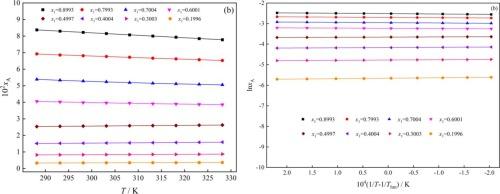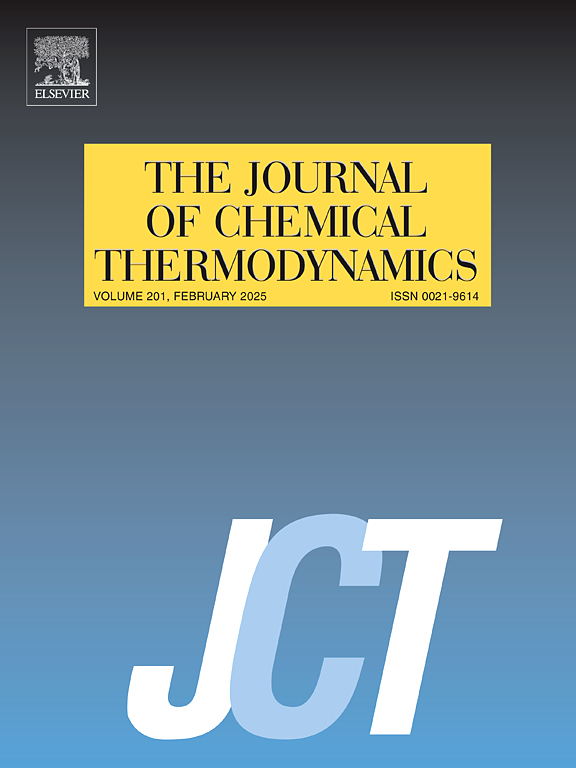ε-CL-20 在 288.15 至 328.15 K 四种二元溶剂(乙酸乙酯 + 卤代烃)中的溶解度测量、相关性和热力学分析
IF 2.2
3区 工程技术
Q3 CHEMISTRY, PHYSICAL
引用次数: 0
摘要
本研究采用重量法测定了ε-CL-20 在由醋酸乙酯和卤代烃(溴苯、氯苯、二溴甲烷、1,1,2,2-四氯乙烷)组成的四种二元溶剂中的溶解度,温度范围为 288.15-328.15 K,压力为 0.101 MPa。在类似条件下,ε-CL-20 的溶解度顺序为:乙酸乙酯 + 溴苯 ≈ 乙酸乙酯 + 氯苯 > 乙酸乙酯 + 二溴甲烷 > 乙酸乙酯 + 1,1,2,2-四氯乙烷,且溶解度随卤代烃含量的增加而降低。结果还显示,当卤代烃的摩尔分数较低时,溶解度与温度呈负相关,反之则相反。修正的 Apelblat 模型、van't Hoff 模型、CNIBS/R-K 模型、Jouyban-Acree 模型和 Jouyban-Acree-van't Hoff 模型被用来关联实验溶解度数据,所有模型均表现良好。修正的 Apelblat 模型和 Jouyban-Acree-van't Hoff 模型相对较好。计算并分析了ε-CL-20 在四种二元溶剂中的溶解热力学性质。结果表明,ε-CL-20 的溶解过程是熵驱动的非自发过程。这项工作对ε-CL-20 的结晶设计和优化具有重要意义。本文章由计算机程序翻译,如有差异,请以英文原文为准。

Solubility measurement, correlation, and thermodynamic analysis of ε-CL-20 in four binary solvents (ethyl acetate + halogenated hydrocarbon) from 288.15 to 328.15 K
In this work, the solubility of ε-CL-20 in four binary solvents composed of ethyl acetate and halogenated hydrocarbons (bromobenzene, chlorobenzene, dibromomethane, 1,1,2,2-tetrachloroethane) was measured over the temperature range of 288.15–328.15 K at 0.101 MPa by gravimetric method. Under similar conditions, the order of solubility of ε-CL-20 is ethyl acetate + bromobenzene ≈ ethyl acetate + chlorobenzene > ethyl acetate + dibromomethane > ethyl acetate + 1,1,2,2-tetrachloroethane and the solubility decreases with the increase of halogenated hydrocarbon content. The results also reveal that the solubility is negatively correlated with temperature when the mole fraction of halogenated hydrocarbons is low, otherwise the result is opposite. The modified Apelblat model, van’t Hoff model, CNIBS/R-K model, Jouyban-Acree model and Jouyban-Acree-van’t Hoff model were used to correlate the experimental solubility data and all of the models perform well. The modified Apelblat model and Jouyban-Acree-van’t Hoff model are relatively excellent. The dissolution thermodynamic properties of ε-CL-20 in four binary solvents were calculated and analyzed. The results show that the dissolution processes of ε-CL-20 are entropy-driven non-spontaneous processes. This work is significant to the design and optimization of the crystallization of ε-CL-20.
求助全文
通过发布文献求助,成功后即可免费获取论文全文。
去求助
来源期刊

Journal of Chemical Thermodynamics
工程技术-热力学
CiteScore
5.60
自引率
15.40%
发文量
199
审稿时长
79 days
期刊介绍:
The Journal of Chemical Thermodynamics exists primarily for dissemination of significant new knowledge in experimental equilibrium thermodynamics and transport properties of chemical systems. The defining attributes of The Journal are the quality and relevance of the papers published.
The Journal publishes work relating to gases, liquids, solids, polymers, mixtures, solutions and interfaces. Studies on systems with variability, such as biological or bio-based materials, gas hydrates, among others, will also be considered provided these are well characterized and reproducible where possible. Experimental methods should be described in sufficient detail to allow critical assessment of the accuracy claimed.
Authors are encouraged to provide physical or chemical interpretations of the results. Articles can contain modelling sections providing representations of data or molecular insights into the properties or transformations studied. Theoretical papers on chemical thermodynamics using molecular theory or modelling are also considered.
The Journal welcomes review articles in the field of chemical thermodynamics but prospective authors should first consult one of the Editors concerning the suitability of the proposed review.
Contributions of a routine nature or reporting on uncharacterised materials are not accepted.
 求助内容:
求助内容: 应助结果提醒方式:
应助结果提醒方式:


